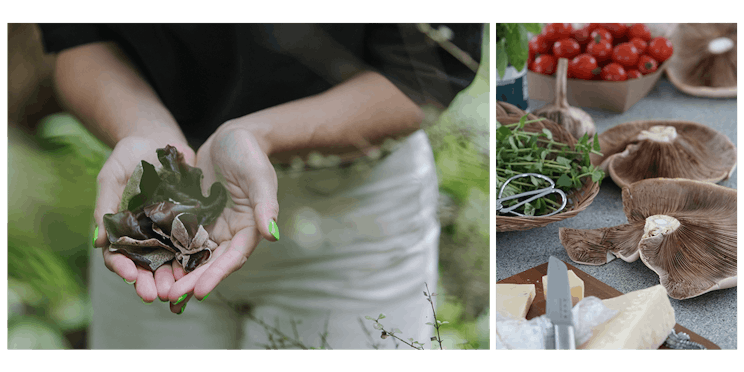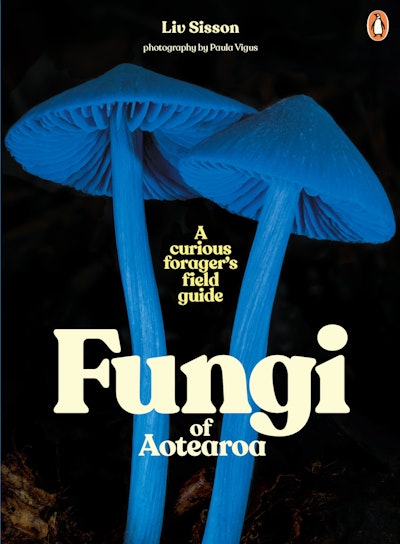- Published: 2 May 2023
- ISBN: 9781761047879
- Imprint: Penguin
- Format: Paperback
- Pages: 336
- RRP: $45.00
Fungi of Aotearoa
A Curious Forager's Field Guide
Extract
4
Edible fungi
Skipped straight to this bit? That’s understandable. Wild mushrooms are some of the most romantic and special ingredients out there. But this is not an area to rush through. Use the previous sections to get up to scratch on your fungi identification and foraging skills, then dive into this section to learn more about the edible fungi of Aotearoa.
As we’ve learned in this book, fungi can make delicious and nutritious food. I’ve loved learning how to forage for fungi and remember lots of my finds individually. From field mushrooms to tawaka, there are more than a few tasty species to find out there.
Of course, fungi foraging is not a new practice. Māori culinary tradition includes fungi as food (and medicine) alongside the other bounties the native bush offers. Over a dozen fungi species have been recorded as being used in Aotearoa as food resources.
Going slow while foraging fungi is always key. Double check you’re allowed to forage in the area where you’re looking. Investigate if the area might be sprayed. Take your time to get a positive ID. And make sure you read pages 88–91 for information about how to forage respectfully, reciprocally and safely.
In my experience, foraging fungi is a game of inches. It’s unlikely that you’ll find multiple new-to-you edible species that you can positively identify on just one walk. I think of it like making good friends. It’s hard to add a bunch to your inner circle all at once. And if you hurry, you could end up with some bad/toxic ones in the lot. I’ve only ever been able to add one species at a time to the group I ‘know’. And sometimes these additions are spaced out by months or even entire seasons. Experimenting with foraged fungi in the kitchen is a whole other adventure. I’m still learning about fungi to forage, and how to use them. It’s a foodie journey without end, really.
Fungi as food
The world is your oyster mushroom. That’s how one top New Zealand chef described the world of edible fungi to me. Heaps of us have unhappy memories of slimy shrooms being served up to us as children. Even me. Fungi, though, make fantastic and often surprising food.
Here are some of the most interesting fungi foods I’ve come across in Aotearoa. Slippery jack mushroom burgers, grilled over charcoal, with a dash of pine oil, served over a bed of creamy mushroom-stock polenta. Mushroom mince dumplings. A porcini mushroom chocolate mousse Yule log. Those first two dishes come from Max Gordy, and the third from Vicki Young — both are top Wellington chefs. When we think outside of the ‘mushrooms on toast’ box, we find that fungi offer us untapped foodie potential.
People who don’t like mushrooms just might not have tried the right one yet. There’s such a wide scope out there, a huge amount of diversity, and they’re good for you too. To cook with mushrooms at home and make them sing, follow these tips gathered from some of the best chefs and fungi fans around Aotearoa.
• Tidy them up — use a tea towel or pastry brush to remove dirt or debris. If you want to wash them, wash them gill side down, otherwise water will get trapped in the gills and make them slimy.
• If you want your mushrooms to remain firm, sweat them off. Put them in a hot pan with a bit of oil and cook them out, but don’t add salt — the salt will draw out the moisture and the mushrooms will quickly go soft and stick to the pan.
• Dice them up to make a mushroom mince. Add a bit of oil to your pan to spread the heat around evenly. When it’s hot, add your mushrooms. Once you start to see them caramelising on the edges, add a bit of water, white wine or vinegar to de-glaze the pan. You can add your mushroom mince to just about anything.
• If you’ve got heaps of mushrooms, you can always dehydrate them. Slice them, then leave them in a sunny corner on a baking tray, or in the oven with the door open at a low temp and under supervision. Store and add to soups and stocks. Or powder them to make your very own umami sprinkle.
Growing your own
The journey of finding, identifying and safely foraging edible fungi is fun, but it isn’t fast. It takes a while to build up your knowledge and skill. In the meantime, though, you can grow your own edible mushrooms. Little mushroom farms doing just that can be found up and down Aotearoa. When I first moved to Ōtautahi Christchurch, I didn’t really know anyone. So when the owners of a small mushroom farm offered to show me their operation, I went.
Taylor and Susan, who are now my friends, started Sporeshift Mushrooms to grow fungi food in a way that’s good for people and the planet. They taught me that growing mushrooms can be super-sustainable. You can grow indoors in a controlled environment with little waste, and you can use vertical space, too, which massively increases output per hectare. Agricultural and forestry waste products can be used as the growing substrate, and what remains after the mushroom harvest can be turned into nutritious garden compost.
Almost anyone can get into mushroom-growing. Starting out with a mushroom grow block is probably the way to go— these can be purchased online from Sporeshift and other producers around the country. If you go well with those and really want to go further, you can make your own grow blocks. This is a big jump up, though — you’ll need a flow hood, a sterile environment and lab equipment.
If you’re not keen to turn your garage into a lab, try coplanting in the garden. Studies have shown that wine cap mushrooms, for example, can boost corn’s ability to produce delicious ears. These mushrooms are prolific decomposers, they digest organic matter in the soil, and this adds nutrients to the system that the hungry corn eagerly convert into sweet kernels. To start companion planting with fungi, add woodchips and mushroom spawn to your soil. This can be purchased online. Wine caps, and other tasty species like the phoenix oyster mushroom, can be grown this way.

Fungi of Aotearoa Liv Sisson
The complete introduction to finding, identifying and using mushrooms and other fungi in New Zealand
Buy now










